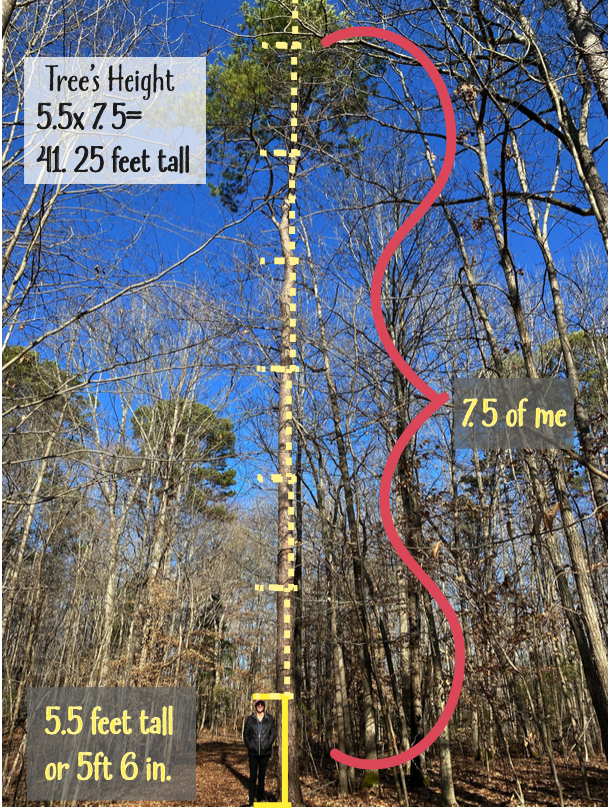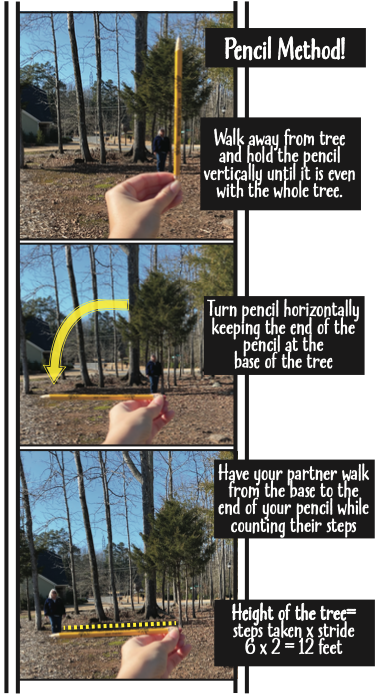does your tree measure up?
We already discovered that trees come in many shapes (learn more about tree shapes) but they also come in many different sizes.
Some tree species tend to be tall like fir trees and others are on the shorter side like Japanese Maples. Do you know how big the tallest tree in the world is? It is a redwood tree in California- named Hyperion, and is 379.7 feet or 115.7 meters tall! It is estimated to be between 600 and 800 years old. WOW!
Measuring A Tree’s Height:
Think about the methods and tools that you use to measure things around you. Will any of those tools help you measure the height of a tall tree? (If doing this activity with kids, be sure to have them brainstorm about how to measure BEFORE you discuss the measuring methods below!) Probably not, as your ruler or meter stick just isn't long enough, but we have some fun methods for you to experiment with and see which works best for you.
Methods for Measuring the Height of Trees:
(You can use any unit of measurement your learners are familiar with!)
1. Estimate using YOU as a measurement tool
Use a measuring tool to measure your height and round off to the nearest number (example 4 feet or 121 cm)
Stand next to the tree you want to measure and notice where the top of your head hits the tree
Look at the height of the tree and estimate how many of you it would take to reach the top of the tree, if you could stack yourself one on top of another
Count on by that number or multiply your height by how many of you it would take to reach the top of the tree (for example -you are 4 feet tall and you guess that it will take 5 of you to reach the height of the tree-you can estimate that the tree is 5x4 or 20 feet tall.
*Feel free to take a picture (like we did!) and let your children check their mental math using pencil, a ruler, and paper afterwards!
(or a drawing app works too…)
2. Under the legs peek method
Find a tree to measure that is on level ground with no obstacles in the way
Begin with your back to the tree and start walking away from the tree
Stop occasionally, bend over and peek through your legs at the tree. Look to see if you can see the very top of the tree. If you can't keep walking away and checking. Once you can see the top of the tree through your legs STOP. Mark the spot you are in when the top of the tree is visible.
Now measure the distance from your marked spot to the base of the tree and you have an approximate height of the tree. ( You can measure using a tool like a measuring tape, meter stick, or you can use the Stride Method- look below to learn how!)
Stride Method
A great way to measure a long distance is using the stride method. To prepare for this method you will need to find out what your average stride is. To do this-mark off a length of 10 feet. Walk the 10 foot length several times, counting your steps each time.
How many steps on average do you take? Divide this number by 10 and you have your stride measurement. Now you can walk the length and simply multiply the length by your stride. For example if I walk the 10 feet and each time I count about 5 steps, then 5 is my average amount of steps. To find my stride I divide 10/5 and discover that my stride is 2.
(If I walked 20 steps from my marked space to the base of the tree, then the tree would be 20 x 2 or 40 feet tall.)
3. Pencil partner method
For this activity you will need a partner, a pencil, and either a measurement tool OR to know your stride measurement from above
Have your partner stand directly beside the tree while you walk away from the tree
Look back occasionally as you walk away. When you look back hold the pencil vertically at arms length from you and line it up with the tree
Keep walking until the bottom of the tree is level with the bottom of the pencil and the top of the tree is level with the point of the pencil
Stop in this spot and turn the pencil sideways (horizontally) keeping the bottom of the pencil at the base of the tree
Now have your partner start walking away from the tree
You will need to yell Stop when you see your partner at the tip of the pencil
Mark the spot where your partner has stopped. The distance from your partner to the base of the tree is the height of the tree
You can measure this distance with a measuring tool or use the stride method from above
Children love the idea of big and tall things like dinosaurs and skyscrapers. Build on this fascination and get them outdoors and looking up. Challenge them to find the tallest tree in the neighborhood or in the schoolyard and then use the above methods to measure to see who found the tallest tree. Children will be problem solving, measuring, counting, skip-counting, estimating, developing both science and math skills AND enjoying time out in nature. Children will come to appreciate these giants living among us.
Get ready for the release of our very first:
‘Explore More’ Learning Magazine!
Our Learning Magazines are almost entirely black and white for easy printing & can be assembled with one simple staple! Each magazine will be something children can either do on their own, in a small group, or with an adult (parent, teacher, etc.). We do not specify an age recommendation for the learning magazines because the prompts will be open-ended for children to explore at their own developmental level.
So what is in each Learning Magazine?
Spaces for brainstorming and reflecting
Academic/creative outdoor learning activity pages (these pages are aids to get children to be hands-on and engaged in nature by guiding them to make observations, record measurements, write thoughts/creative expressions, make plans, and do experiments)
There will be an activity page about Measuring Trees!
A new curiosity to help spark children’s wonderment and encourage them to be curious about their world
A fun page filled with nature-based games, puzzles, or riddles
A creativity focused page for children to express themselves
“Perfect for: homeschooling, teachers wanting to incorporate more nature into their curriculum, guided self-learning, learning extensions, and curious nature-minded children.”
This first learning magazine is now available in our SHOP
Subscribe to our emails to never miss a new Learning Magazine Release.





